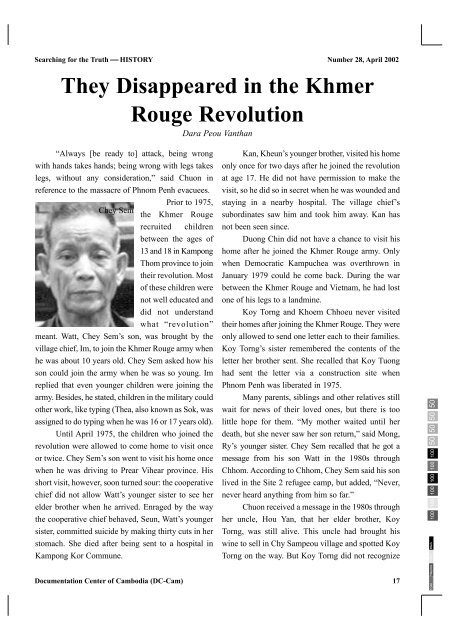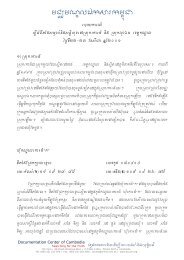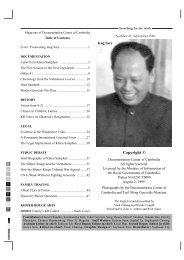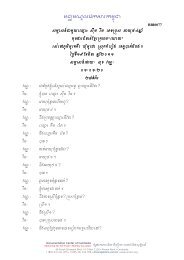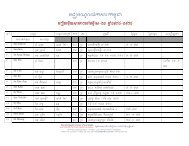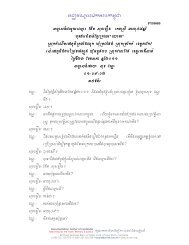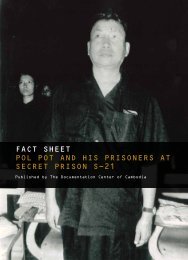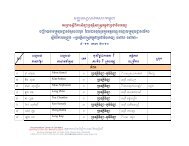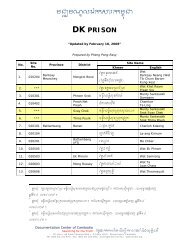Searching for the truth Issues 28 - Documentation Center of Cambodia
Searching for the truth Issues 28 - Documentation Center of Cambodia
Searching for the truth Issues 28 - Documentation Center of Cambodia
You also want an ePaper? Increase the reach of your titles
YUMPU automatically turns print PDFs into web optimized ePapers that Google loves.
<strong>Searching</strong> <strong>for</strong> <strong>the</strong> Truth ⎯ HISTORY<br />
Number <strong>28</strong>, April 2002<br />
They Disappeared in <strong>the</strong> Khmer<br />
Rouge Revolution<br />
Dara Peou Vanthan<br />
“Always [be ready to] attack, being wrong<br />
with hands takes hands; being wrong with legs takes<br />
legs, without any consideration,” said Chuon in<br />
reference to <strong>the</strong> massacre <strong>of</strong> Phnom Penh evacuees.<br />
Prior to 1975,<br />
Chey Sem<br />
<strong>the</strong> Khmer Rouge<br />
recruited children<br />
between <strong>the</strong> ages <strong>of</strong><br />
13 and 18 in Kampong<br />
Thom province to join<br />
<strong>the</strong>ir revolution. Most<br />
<strong>of</strong> <strong>the</strong>se children were<br />
not well educated and<br />
did not understand<br />
what “revolution”<br />
meant. Watt, Chey Sem’s son, was brought by <strong>the</strong><br />
village chief, Im, to join <strong>the</strong> Khmer Rouge army when<br />
he was about 10 years old. Chey Sem asked how his<br />
son could join <strong>the</strong> army when he was so young. Im<br />
replied that even younger children were joining <strong>the</strong><br />
army. Besides, he stated, children in <strong>the</strong> military could<br />
o<strong>the</strong>r work, like typing (Thea, also known as Sok, was<br />
assigned to do typing when he was 16 or 17 years old).<br />
Until April 1975, <strong>the</strong> children who joined <strong>the</strong><br />
revolution were allowed to come home to visit once<br />
or twice. Chey Sem’s son went to visit his home once<br />
when he was driving to Prear Vihear province. His<br />
short visit, however, soon turned sour: <strong>the</strong> cooperative<br />
chief did not allow Watt’s younger sister to see her<br />
elder bro<strong>the</strong>r when he arrived. Enraged by <strong>the</strong> way<br />
<strong>the</strong> cooperative chief behaved, Seun, Watt’s younger<br />
sister, committed suicide by making thirty cuts in her<br />
stomach. She died after being sent to a hospital in<br />
Kampong Kor Commune.<br />
<strong>Documentation</strong> <strong>Center</strong> <strong>of</strong> <strong>Cambodia</strong> (DC-Cam)<br />
Kan, Kheun’s younger bro<strong>the</strong>r, visited his home<br />
only once <strong>for</strong> two days after he joined <strong>the</strong> revolution<br />
at age 17. He did not have permission to make <strong>the</strong><br />
visit, so he did so in secret when he was wounded and<br />
staying in a nearby hospital. The village chief’s<br />
subordinates saw him and took him away. Kan has<br />
not been seen since.<br />
Duong Chin did not have a chance to visit his<br />
home after he joined <strong>the</strong> Khmer Rouge army. Only<br />
when Democratic Kampuchea was overthrown in<br />
January 1979 could he come back. During <strong>the</strong> war<br />
between <strong>the</strong> Khmer Rouge and Vietnam, he had lost<br />
one <strong>of</strong> his legs to a landmine.<br />
Koy Torng and Khoem Chhoeu never visited<br />
<strong>the</strong>ir homes after joining <strong>the</strong> Khmer Rouge. They were<br />
only allowed to send one letter each to <strong>the</strong>ir families.<br />
Koy Torng’s sister remembered <strong>the</strong> contents <strong>of</strong> <strong>the</strong><br />
letter her bro<strong>the</strong>r sent. She recalled that Koy Tuong<br />
had sent <strong>the</strong> letter via a construction site when<br />
Phnom Penh was liberated in 1975.<br />
Many parents, siblings and o<strong>the</strong>r relatives still<br />
wait <strong>for</strong> news <strong>of</strong> <strong>the</strong>ir loved ones, but <strong>the</strong>re is too<br />
little hope <strong>for</strong> <strong>the</strong>m. “My mo<strong>the</strong>r waited until her<br />
death, but she never saw her son return,” said Mong,<br />
Ry’s younger sister. Chey Sem recalled that he got a<br />
message from his son Watt in <strong>the</strong> 1980s through<br />
Chhom. According to Chhom, Chey Sem said his son<br />
lived in <strong>the</strong> Site 2 refugee camp, but added, “Never,<br />
never heard anything from him so far.”<br />
Chuon received a message in <strong>the</strong> 1980s through<br />
her uncle, Hou Yan, that her elder bro<strong>the</strong>r, Koy<br />
Torng, was still alive. This uncle had brought his<br />
wine to sell in Chy Sampeou village and spotted Koy<br />
Torng on <strong>the</strong> way. But Koy Torng did not recognize<br />
17<br />
100 100 100 100 100 100 50 50 50 50<br />
Black<br />
Yellow<br />
Magenta<br />
Cyan


